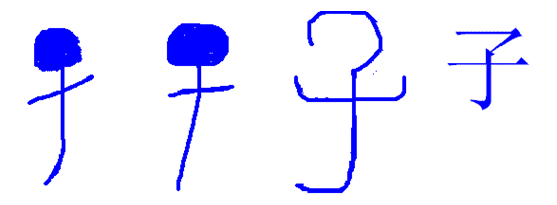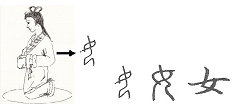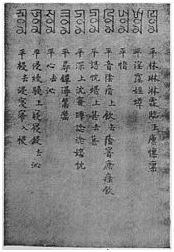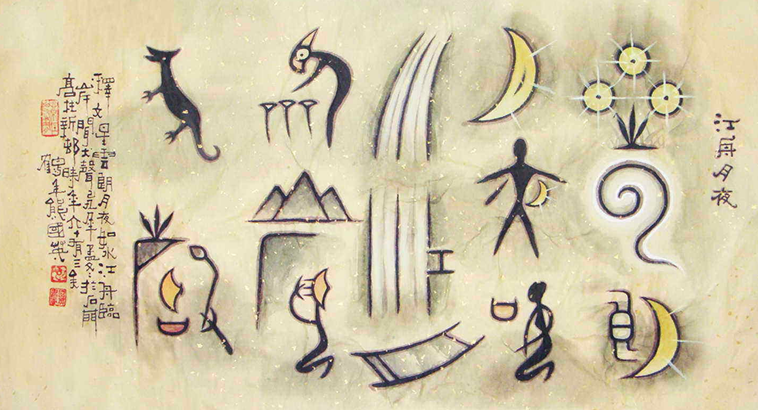Do you Know Mike Sui?
There are many interesting stories happened in your journey of Mandarin learning.
Recently, Mike Sui is very popular among Chinese learners. Have a look at his performance at the bar.
He imitated different accents in this short video:
Hope you enjoy your learning with Our SLS excellent teachers!
Learning Chinese Characters Without Rote Learning
To learn Chinese characters, first of all we will need to know some history and features about this ancient writing. The history of Chinese characters can be traced back into more than 3000 years ago, and at the very beginning of its development most Chinese characters are “pictographic”, which means you can easily guess the meaning by looking at the shape of the characters. The examples are 木(mù) (wood or tree),目(mù) (eye). Both characters have the same pinyin. The former character ‘木” used to be looking like  , which by the shape looks like a tree. The top horizontal stroke imitates the branches of a three whereas the bottom two strokes imitate the roots of a tree. The latter character “目” originally looks like
, which by the shape looks like a tree. The top horizontal stroke imitates the branches of a three whereas the bottom two strokes imitate the roots of a tree. The latter character “目” originally looks like  and is actually a picture of an eye.
and is actually a picture of an eye.
As time goes by, only using picturesque characters could not meet the increasing demand of Chinese characters. There then came other groups of Chinese characters. One of those groups is called “indication”, which means you can guess the meaning by looking at different parts of the characters. For example, the character “林(lín)” 
 has two trees in one character. The word “林” means “forest”, which actually indicated by the parts of the character. Instead of using rote learning to remember Chinese characters, we can learn characters much more efficiently by analysing the development of the characters and their features.
has two trees in one character. The word “林” means “forest”, which actually indicated by the parts of the character. Instead of using rote learning to remember Chinese characters, we can learn characters much more efficiently by analysing the development of the characters and their features.
Another important group, which represents a very characteristic feature of Chinese characters, is called “picot-phonogram”. The characters in this group are often composed of two parts (mostly left-right structure), and the left part indicate meaning of the characters (usually pictographic characters) whereas the right part indicate the pronunciation of the characters. For example, the word “淋(lín)” (meaning “get wet”) has its meaning part  in its left and the phonetic part “林”
in its left and the phonetic part “林” 
 in its right.
in its right.
Why Chinese characters?
After learning Chinese for a while, many students feel that the more they learn, the more confused they sometimes get about this language. For example, pinyin “tā” can mean “he”, “she” or “it”,and “jī” can either mean “chicken” or “machine”. However, when we have a look at their according Chinese Characters, we will find though they have exactly the same pinyin, they actually have different Chinese characters to go with them. That is the reason why start from pre-intermediate course, we are introducing more and more Chinese characters during the lessons.
Moreover, through learning Chinese characters, it will not only help the students get a better understanding of the Chinese language, but also introduce them cultures and ways of thinking of Chinese people. Let me take an example of the word “女(nǚ)” (meaning woman or women), which is actually a pictographic word whose ancient form looks like  . This original form for woman depicted her in a bowing position with two arms crossed together like a servant. It is shows humbleness and inferiority position of women in Chinese culture when the word was created. In ancient Chinese culture, women neither went to school to receive education nor went out for work. Instead, they were the group who are doing the housework and serving their husbands. Of course, things have been changed for so long and in modern China women generally have the equal right for education and work as men do. But still, in some parts of China, especially in rural areas, people still believe only sons can carry the family lines and therefore much more important than daughters.
. This original form for woman depicted her in a bowing position with two arms crossed together like a servant. It is shows humbleness and inferiority position of women in Chinese culture when the word was created. In ancient Chinese culture, women neither went to school to receive education nor went out for work. Instead, they were the group who are doing the housework and serving their husbands. Of course, things have been changed for so long and in modern China women generally have the equal right for education and work as men do. But still, in some parts of China, especially in rural areas, people still believe only sons can carry the family lines and therefore much more important than daughters.
Would it be interesting and helpful to learn some Chinese culture through learning Chinese characters?
By Anne Ma (Mandarin Language Consultant)
Methods for Learning Mandarin
Visual Methods for Learning Mandarin Chinese
• Use textbooks, flashcards
• Make notes, lists and diagrams
• Watch Mandarin-language videos
• Use coloured highlighters for various language functions like verbs, nouns, measure words etc.
Auditory Methods for Learning Mandarin Chinese
• Use audio materials like CDs and MP3 files
• For classroom study, ask if you can record the lessons
• Watch Mandarin-language videos and listen to Mandarin radio
• Record all your written notes
Kinaesthetic Methods for Learning Mandarin Chinese
• Use flashcards and interactive software
• Play role-playing games and practice dialogs with a partner
• Study in the language lab and with other people
• Find a language-exchange partner
Tenses in Mandarin
Unlike tenses in English grammar, verbs do not change forms in Chinese grammar, instead, additional words are added to indicate different tenses. For instance, if I want to address “I am having dinner”, I would say “wǒ zài chī fàn”. On the other hand, if I want to describe “I had dinner”, I would say “wǒ chī guò fàn le”. Besides, if I want to express “ I am going to have dinner”, I would use “wǒ yào chī fàn”. In short, verbs are remaining the same form as they are in different tenses such as present tenses, past tenses and future tenses.
In Chinese, words such as “guò”, “yǐ jing”, “céng jīng”, “wán” are utilized to imply past tenses, whereas words like “zhèng zài”, “zài”, “zhèng” indicate present tenses. In other cases, the indicators including “yào”, “jiāng”, “hui”, “jiāng yào” depict future tenses.
Therefore, it is important to remember tenses indicators to identify different tenses in Chinese.
Useful websites for learning Mandarin
嗨,大家好。
Hi, everyone!
Welcome back to Mandarin Blog.
Today, I will introduce two useful websites to Chinese learners.
1. http://www.standardmandarin.com/chinesephrases/Australia
You could find Chinese characters and pinyin forms from this website and you could also click for the pronunciation as well. This is a very good website for beginners.
2. http://www.nciku.com/
For those learners who want to learn writing, nciku will be quite helpful as you could search the characters from this website. They also teach you some practical Chinese conversation everyday.
Learning is a very interesting process that makes you feel fulfilling everyday.
Please share your learning experience with us。
好好学习,天天向上。
Learning Chinese Characters through China’s history and culture
I often hear students say that Chinese characters seem to be overwhelming because they are so varied and some of them contain “numerous” stokes. As most learning requires effective ways, learning Chinese characters has its unique way as well.
Besides the pictographic characteristics of Chinese characters (as clarified in “Chinese characters as a form of visual art”), some Chinese characters also indicate the history and culture aspect of China. If you are learning Chinese characters through the stories about Chinese culture and history, it would make the learning more interesting and rewarding. Let’s have a look at the following examples.
The character “子” is a pictographic character (see picture 2.1.). In ancient times, the character “ ” means “children” when it is a radical of a character or “son” when it is a character by itself. The character looks like a baby with a big head while holding up two hands. The character has developed over the time but its modern version still holds some pictographic characteristics.
” means “children” when it is a radical of a character or “son” when it is a character by itself. The character looks like a baby with a big head while holding up two hands. The character has developed over the time but its modern version still holds some pictographic characteristics.

Picture 2.1. the development of Chinese character “子”
The character “女” is more than a pictographic Chinese character (see picture 2.2.). The original version of the Chinese character “女” (meaning female) looks like a lady with both her legs kneeled down. It was created to mean that women in ancient China usually stay at home waiting for either her father (before marriage) or her husband (after marriage) to come back.
This character “ ” (meaning female) also looks like a servant because of its unique posture. This indicates that ancient China is a male-dominate society and women are subordinate to males. In ancient times, Chinese women neither go for work nor go to schools, and the most important work for them is to take care of their husbands and children. In modern times, Chinese women not only receive higher education but also go for work, but they still regard family lives as the most important things in their lives.
” (meaning female) also looks like a servant because of its unique posture. This indicates that ancient China is a male-dominate society and women are subordinate to males. In ancient times, Chinese women neither go for work nor go to schools, and the most important work for them is to take care of their husbands and children. In modern times, Chinese women not only receive higher education but also go for work, but they still regard family lives as the most important things in their lives.

Picture 2.2. the development of Chinese character “女”
When we combine the above two characters (女+子,see picture 2.2. and picture 2.1.) together, we will have the character “好” (Hǎo, meaning “good” ). The character “好” is created with the meaning that it is a good thing when a woman has a child. It indicates that Chinese people pay significant attention of having offspring. There is a Chinese saying goes like this; there are three forms of unfilial conduct of which the worst is to have no descendants.
Anne Ma
Mandarin Language Consultant
Old Mandarin

After the fall of the Northern Song dynasty, northern China was under the control of the Jin (Jurchen) and Yuan (Mongol) dynasties. During this period, a new common speech developed, based on the dialects of the North China Plain around the capital, a language referred to as Old Mandarin. New genres of vernacular literature were based on this language, including verse, drama and story forms.
The rhyming conventions of the new verse were codified in a rhyme dictionary called the Zhongyuan Yinyun (1324). A radical departure from the rhyme table tradition that had evolved over the previous centuries, this dictionary contains a wealth of information on the phonology of Old Mandarin. Further sources are the ‘Phags-pa script based on the Tibetan alphabet, which was used to write several of the languages of the Mongol empire, including Chinese, and the Menggu Ziyun, a rhyme dictionary based on ‘Phags-pa. The rhyme books differ in some details, but overall show many of the features characteristic of modern Mandarin dialects, such as the reduction and disappearance of final stop consonants and the reorganization of the Middle Chinese tones.
What is Mandarin?
As we know, China is such a big country with 55 ethnic minorities. And most of the minorities have their own dialects. Besides, people from different regions of China have different accent as well. So, the Chinese government promoted Mandarin all around the country for a purpose of better communication and education from 1956.
Here are some background information about Mandarin. I hope it will be helpful for your understanding and learning.
In Chinese linguistics, Mandarin refers to a group of related Chinese dialects spoken across most of northern China. Because most Mandarin dialects are found in the north, the group is also referred to as the "northern dialect(s)" .
A northeastern-dialect speaker and a southwestern-dialect speaker can hardly communicate except through the standard language, mainly because of the differences in tone. When the Mandarin group is taken as one language, as is often done in academic literature, it has more native speakers (nearly a billion) than does any other language. For most of Chinese history, the capital has been within the Mandarin area, making these dialects very influential. Mandarin dialects, particularly the Beijing dialect, form the basis of Standard Chinese, which is also known as "Mandarin".
Chinese character as a kind of visual art

Learning Mandarin usually starts from Pīnyīn, which is a phonetic system that helps people to speak Chinese language. However, Pīnyīn is only part of Chinese language because Chinese language actually consists both sound (Pīnyīn) and symbol (Chinese characters). Chinese character has a history of almost 5000 years, which is almost as long as Chinese history. The different writing systems of the world can be divided into two categories, which are alphabetic writing system and semantic writing system. Chinese writing system is semantic system in which people differentiate the meaning of words according to their forms.
Some Chinese learners said that Chinse characters were like pictures. I would say they are right, considering that pictographs are an integral part and the foundation of Chinese characters. Let’s have a look at some pictographic examples in Chinese characters as follows. You may notice that they are developed from concrete objects and can be regarded as a form of visual art.
![]()
1.1. The development of the Character “rì”, which means “sun”.

1.2. The development of the character “yuè”, which means “moon”.

1.3. The development of the character “shuǐ”, which means “water”.
There are a lot other examples about pictographic Chinese characters and we will be discussing them in the later sessions.
-Anne Ma



Latest Comments